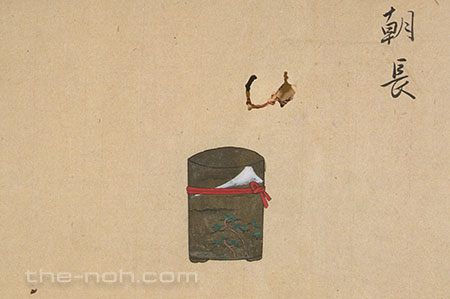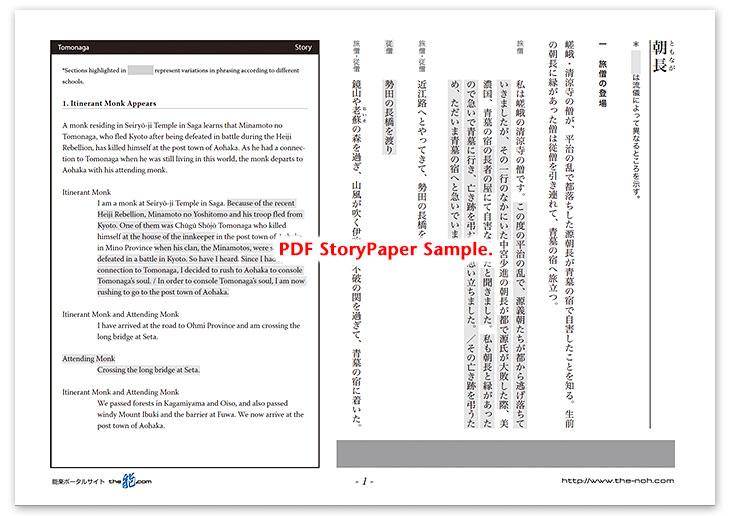
 Tomonaga
Tomonaga

![]()
After the Minamoto forces suffered a defeat in a battle during the Heiji Rebellion of 1160, Minamoto no Tomonaga, the second son of Minamoto no Yoshitomo, was en route fleeing from Kyoto when he took his own life at the inn of Aohaka in Mino Province. The son of Tomonaga’s wet nurse, who is now a monk of Seiryō-ji Temple in Saga, Kyoto, hears about Tomonaga’s death and visits Aohaka to console his soul. A female innkeeper from Aohaka feels a karmic connection to Tomonaga as she offered him an accommodation for the night, so she performs memorial services for him. The innkeeper encounters the monk, who has come to Aohaka, and together they pray for Tomonaga’s soul. At the monk’s request, the innkeeper describes Tomonaga’s final moments. She explains that since he had been shot in the knee by an arrow, he chose to kill himself rather than be killed by his enemy.—Having passed the night reciting the invocation, “Namu Amida Buddha,” he died by his own hand. Learning of the death of his son, Yoshitomo and his troops were plunged into deep grief. The sun has already set, so the innkeeper now offers the monk lodging for the night, which he accepts.
When the monk starts to perform a memorial service including the Kannon Bodhisattva method of repentance that Tomonaga valued while he was alive, the ghost of Tomonaga appears. He expresses his appreciation to the monk for conducting a memorial service to console his soul, narrates the events of the battle in which the Minamoto troops were defeated, and laments the impermanence of this world. Although he vows to be reborn in Amida’s Pure Land, he is still wearing armor representative of an asura (warrior). After describing the final moments of his life, Tomonaga asks the monk to pray for him and vanishes into thin air.
![]()
This Tomonaga, together with Sanemori and Yorimasa, is one of the Three Shura Plays. While Sanemori and Yorimasa describe the worldly attachments of aged warriors, this piece describes the introverted affections and sadness of a young warrior, a monk, and a female innkeeper. Noh actors consider this an advanced play as it has a different shite (lead character) in the first and second half, which makes this unique among shura-mono (warrior plays). This play draws on material found in Heiji Monogatari (The Tale of the Heiji Rebellion), but other than the fact of Tomonaga’s death, its storyline is almost entirely original.
This play tells the simple story of the warmhearted female innkeeper and the monk mourning the death of Tomonaga. However, structure is quite exceptional as the lead character in the first half is not a phantom (the ghost of Tomonaga), but instead is a living person, the innkeeper, who—although a woman—narrates the story of a battle. The female innkeeper’s talk in the first half of the play is full of warmth and sadness as if, through telling the story, she is letting her feelings of affection for Tomonaga, who died at a mere sixteen years old, pour out. In the second half, the atmosphere changes dramatically with the young warrior’s dramatic narration of a battle story, which is described through a series of composed yet brisk movements.
STORY PAPER : Tomonaga
Story Paper presents noh chant stories in modern speech, with story outlines, highlights and more using Adobe PDF format, which can print out and zoom in. Print out the pages and take them with you when you see the actual noh performance.

The copyright of Story Paper is held by the Noh.com. Story Paper is for individual use only. It is prohibited by the copyright law to distribute or publish printed-out Story Paper pages without prior consent. For more information, check the credit and disclaimer pages.



 [Tomonaga : Story Paper PDF : 595KB
[Tomonaga : Story Paper PDF : 595KB